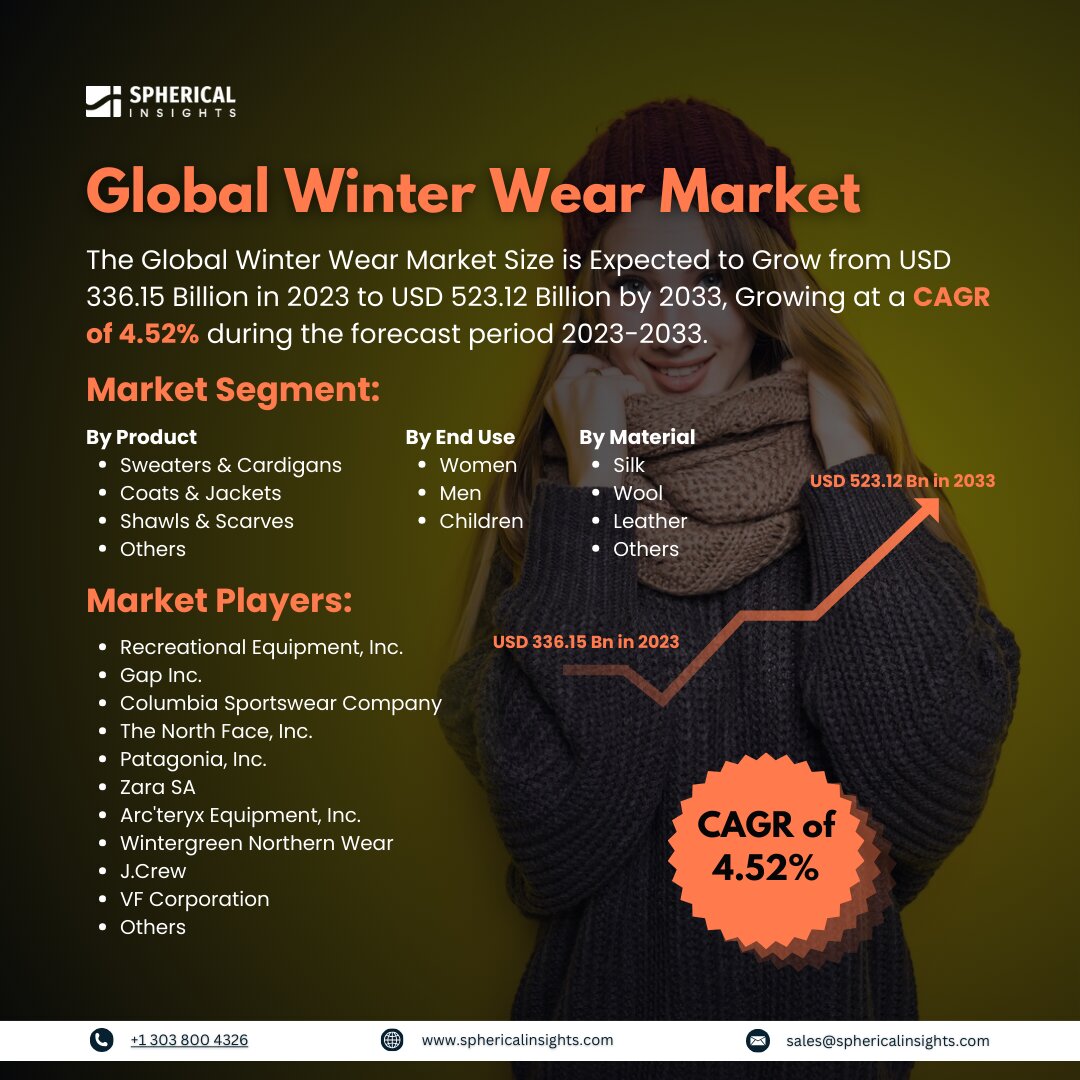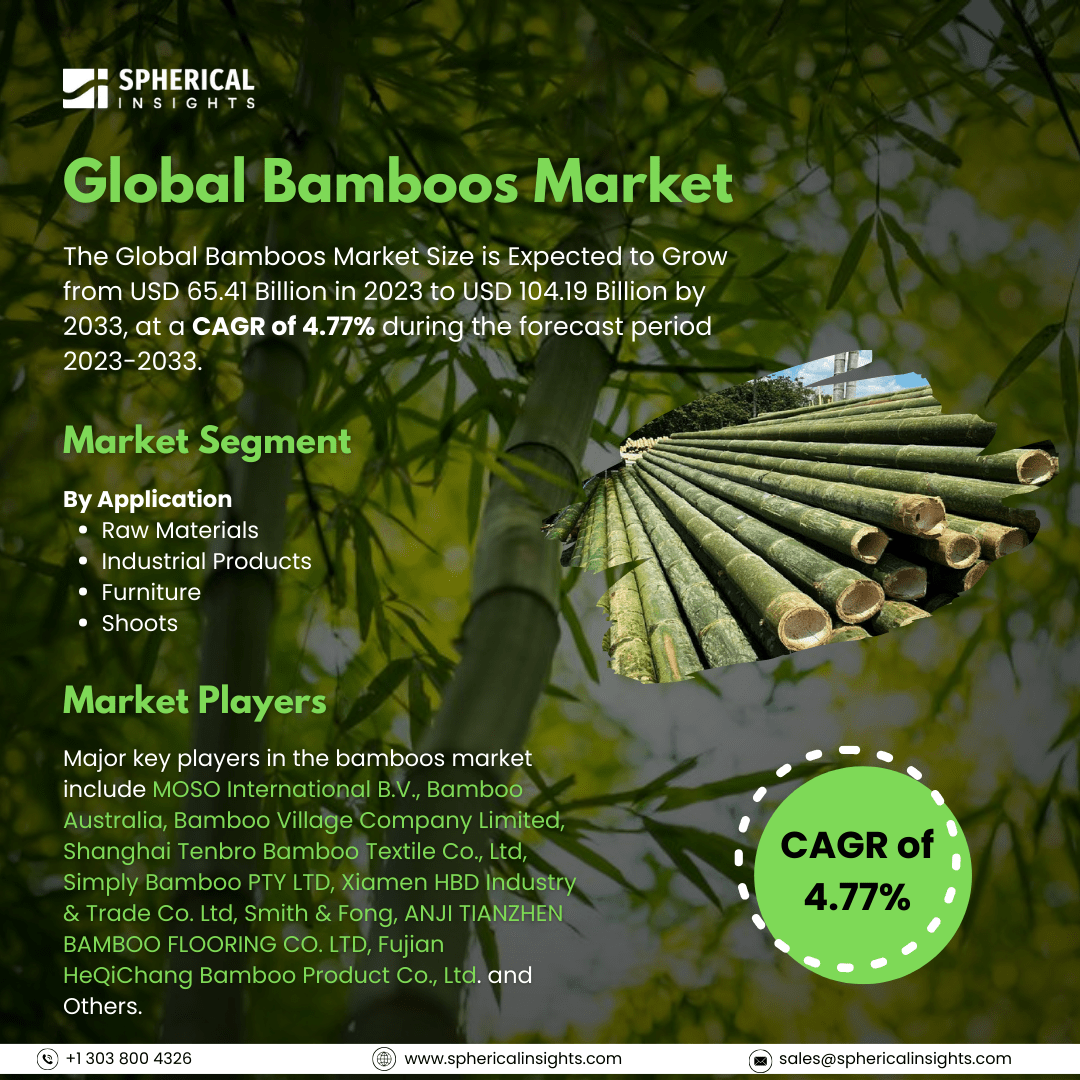Global Winter Wear Market Size to Worth USD 523.12 Billion by 2033
According to a research report published by Spherical Insights & Consulting, the Global Winter Wear Market Size is Expected to Grow from USD 336.15 Billion in 2023 to USD 523.12 Billion by 2033, Growing at a CAGR of 4.52% during the forecast period 2023-2033.
Browse key industry insights spread across 215 pages with 110 Market data tables and figures & charts from the report on the Global Winter Wear Market Size, Share, and COVID-19 Impact Analysis, By Product (Sweaters & Cardigans, Coats & Jackets, Shawls & Scarves, and Others), By End Use (Women, Men, and Children), By Material (Silk, Wool, Leather, and Others), and By Region (North America, Europe, Asia-Pacific, Latin America, Middle East, and Africa), Analysis and Forecast 2023 – 2033.
Clothing and boots worn in the colder months to aid in controlling body temperature are referred to as winter wear. Cardigans, coats, suits, shawls, wraps, and scarves are instances of winter fashion. To satisfy the needs of fashion-conscious individuals worldwide, a variety of stylish winter clothes are on the market. The growing desire for stylish yet effective winter clothing, shifting weather patterns, and growing consumer awareness of winter travel and sports are all factors contributing to this expansion. As the weather becomes more unpredictable due to climate change, people are spending more money on stylish, high-quality winter clothing that keeps them warm. Increased disposable income allowed consumers to spend more on high-end winter clothing, especially in Asia Pacific nations such as China and India. International fashion trends are more widely known and have an impact on shopping decisions as a result of urbanization and the growing influence of social media. Customers are searching for fashionable designs that work well in a variety of situations as well as practical apparel. The need for both functionality and beauty is driving firms to develop and broaden their product lines. However, growing costs of goods and ongoing fashion trend shifts will probably serve as market barriers to winter clothing growth throughout the anticipated period.
The coats and jackets segment is expected to hold the largest market share of the global winter wear market through the forecast period.
Based on the product, the winter wear market is categorized into sweaters & cardigans, coats & jackets, shawls & scarves, and others. Among these, the coats and jackets segment is expected to hold the largest market share of the global winter wear market through the forecast period. Coats and jackets are becoming practical winter clothing pieces that can make design statements. Customers look for fashionable outerwear options that go well with their overall appearance. To keep up with changing fashion trends, fashion designers and brands frequently release new styles, colors, and designs. The seasonality of winter clothing helps the coats and jackets market. To stay warm and stylish throughout the winter, consumers frequently upgrade their outerwear collection. Sales are driven by this cyclical need, which also stimulates innovation. As a result, the market is anticipated to expand quickly over the next several years.
The men segment is predicted to hold a significant market share in the global winter wear market over the projected timeframe.
Based on the end use, the winter wear market is classified into women, men, and children. Among these, the men segment is predicted to hold a significant market share in the global winter wear market over the projected timeframe. Men are becoming more and more aware of fashion, focusing on their look and style. Owing to this change, there has become more demand for winter clothing that blends fashionable styles with utility. Retailers and manufacturers have responded to the increasing demand by providing a broad selection of winter clothing items that are suited to men's tastes. This contains several kinds of jackets, coats, hoodies, sweaters, and accessories. In the future years, these elements will increase demand in the men's market.
The leather segment is anticipated to hold the highest market share of the global winter wear market through the projected period.
Based on the material, the winter wear market is classified into silk, wool, leather, and others. Among these, the leather segment is anticipated to hold the highest market share of the global winter wear market through the projected period. The durability and resistance to deterioration of leather are well-known. Leather apparel is a wise investment because it can last for many years with proper care. Water resistance is inherent in many leather types, including full-grain leather. Leather clothes can resist light rain and snow if it is treated and finished properly. Well-made leather clothes can be worn for many winters. Regular cleaning and periodic conditioning can keep them in good shape for years.
Asia Pacific is expected to hold the largest share of the winter wear market through the forecast period.
Asia Pacific is expected to hold the largest share of the winter wear market through the forecast period. The need for winter clothing has also expanded due to a rising population base, especially in nations such as China and India. The industry has expanded even more as a result of shifting weather patterns and the growth of winter travel in nations such as South Korea and Japan. For instance, millions of people visit Japan's ski resorts each winter, which increases the demand for premium winter clothing among both residents and tourists. The majority of consumers are also being encouraged to spend on high-end winter clothing due to changing fashion trends and the growing middle class, which will improve their overall experience during the cold months. The Asia Pacific area leads the worldwide winter wear industry because of a confluence of population dynamics, environmental circumstances, and rising disposable incomes.
Middle East Africa is predicted to grow at the fastest CAGR of the winter wear market over the forecast period. Owing to growing climate change awareness. Customers are investing in winter clothing as a result of unpredictable weather patterns and lower temperatures in some areas. Unexpected temperature decreases in South Africa and the United Arab Emirates have increased demand for winter clothes. Additionally, the market's strong growth in this region can be attributed to the increased customer interest in fashionable winter clothing brought about by global fashion trends and marketing initiatives.
Competitive Analysis
Major key players in the winter wear market include Recreational Equipment, Inc., Gap Inc., Columbia Sportswear Company., The North Face, Inc., Patagonia, Inc., Zara SA, Arc' Teryx Equipment, Inc., Wintergreen Northern Wear, J.Crew, VF Corporation, and others.
Recent Developments
- In October 2024, Gap Inc. launched a limited-edition "Wicked" capsule collection with 20 pieces that were influenced by the popular musical's impending movie version. Colors such as green, pink, and black that are essential to Elphaba and Glinda's personas are featured throughout the collection. Among the essentials are sweatshirts, graphic tees, and accessories such as beanies and socks. This line offers warm and fashionable winter clothing options that are sure to appeal to music lovers.
Key Target Audience
- Market Players
- Investors
- End-users
- Government Authorities
- Consulting And Research Firm
- Venture capitalists
- Value-Added Resellers (VARs)
Market Segment
This study forecasts revenue at global, regional, and country levels from 2023 to 2033. Spherical Insights has segmented the winter wear market based on the below-mentioned segments:
Global Winter Wear Market, By Product
- Sweaters & Cardigans
- Coats & Jackets
- Shawls & Scarves
- Others
Global Winter Wear Market, By End Use
Global Winter Wear Market, By Material
Global Winter Wear Market, By Regional Analysis
- North America
- Europe
- Germany
- UK
- France
- Italy
- Spain
- Russia
- Rest of Europe
- Asia Pacific
- China
- Japan
- India
- South Korea
- Australia
- Rest of Asia Pacific
- South America
- Brazil
- Argentina
- Rest of South America
- Middle East & Africa
- UAE
- Saudi Arabia
- Qatar
- South Africa
- Rest of the Middle East & Africa



